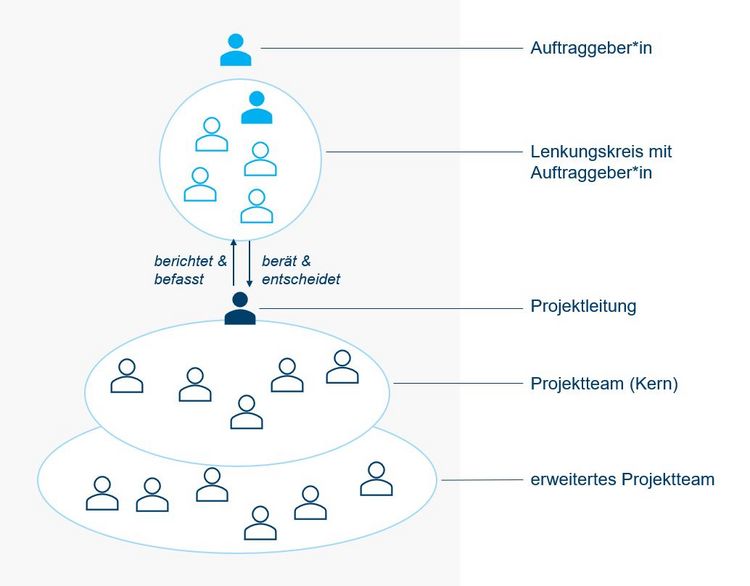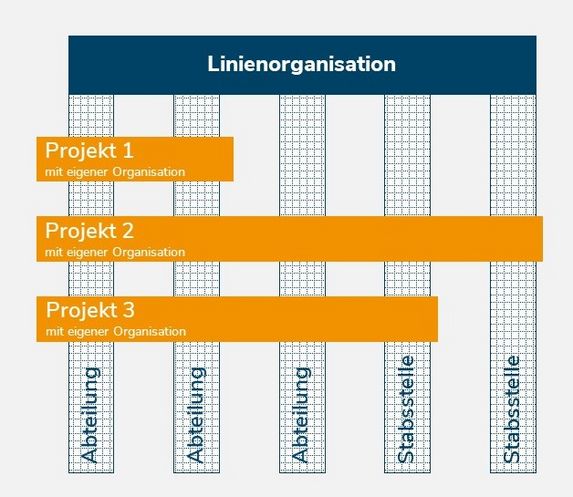Basic information
Contact
Basic information
"A project is a unique, time-limited, multidisciplinary and organised effort to achieve agreed outcomes within predefined requirements and constraints."
(International Project Management Association 2015: 27)
Type and structure
Definition of project / major project
Projects are temporary structures within the organisation: they are set up and then dismantled again when the objectives have been achieved, and also sometimes if it turns out that the objectives cannot be achieved as agreed.
- The purpose of a project is to create or introduce something new / innovative on a one-off basis. These objectives are defined in advance.
- In order to handle such a complex / complicated undertaking, the project creates a framework outside the regular line organisation.
- This brings together people with cross-divisional/departmental expertise who work together on the basis of transparent and agreed roles and rules.
- The scope of the project is always limited, i.e. it has a start and an end and has limited resources (people, money, etc.).
- A project involves changes, e.g. to processes, and certain risks.
In central administration, people are deployed in projects and regular operations at the same time. Both organisational forms overlap. Schematically, this looks like this:
Delimitation of project / major project in central administration
The following orientation framework applies to projects in central administration:
All plans that meet these criteria for major projects and projects are prioritised in the Vice President for Administration and Finance Project Portfolio Board and managed in the Vice President for Administration and Finance project portfolio. The binding standards apply to them.
The guidelines are not binding for project-like tasks or other change measures. However, many aspects of the information in this handbook can be transposed. And here too we’re happy to advise and support all colleagues with change initiatives.
Project stakeholders and their roles
Adequate project organisation with clear responsibilities is one of the binding standards for projects and major projects in central administration.
The project organisation should reflect the scope and complexity of the project / major project. Projects in central administration and service areas require at least one commissioning party, one project manager and one project team. Major projects are usually supplemented by a steering committee made up of no more than 5 people.
The respective functions, duties and powers of the people involved are agreed and clearly communicated in the project.

Commissioning party
- officially commissions an individual project and oversees it through to completion, bears overall responsibility
- is clear in their mission, defines the objectives and the results for the project
- takes time for the project, e.g. through regular information and discussions with project management
- clarifies with project management what their powers are, lets the project team and project management work independently
- intervenes when needed or if project management requests this
- quickly makes the necessary decisions for the project, approves changes to objectives
- makes the final decision and seeks advice from the steering committee
- receives and assesses the reports from project management on the status / progress and on the (interim) results
- considers the fit with university strategies in the overarching project management, gets in touch with the Vice President for Administration and Finance Project Portfolio Board if needed
- puts a stop to the project if it does not bear fruit.
Steering committee
- consists of the commissioning party (chair & final decision-maker) and up to four other people (usually in an advisory capacity) who represent the perspectives of the users and the interests of all those who are significantly affected by the outcome of the project.
- creates the link between the project and university
- meets on an ad hoc basis and is convened by project management or the commissioning party as required
- receives regular information on progress from project management as well as decision papers
- monitors whether the project delivers the intended benefits and whether the objectives are being realised; can check and approve the achievement of milestones
- discusses and decides on requests for planning and alignment or changes thereto; also whether a project is cancelled prematurely
- must be able to meet at short notice in an emergency.
The steering committee can also make decisions jointly, i.e. on an equal footing with the commissioning party, or decisions should be unanimous. This must be considered, agreed, clearly communicated and then also adhered to at the start of a project..
Project team
- is made up of project experts
- regularly comes together to discuss progress with each other and with project management, to assign and prepare upcoming tasks
- also meets on an ad-hoc basis if the project requires.
The members of the project team
- carry out the work described in the work breakdown structure independently: each member assumes responsibility for handling the assigned work package
- document the results of their own work for the project and provide project management with information, e.g. for status reports
- inform project management and any affected colleagues about the status of tasks and work packages
- inform their own manager and possibly colleagues in the department about the progress of the project
- inform project management as early on as possible of (foreseeable) implementation or resource issues or conflicts within and outside the project team
- play a constructive role in problem-solving.
Not all experts have to be part of the core project team for the entire duration of the project. People can also be temporarily assigned to the extended project team for individual tasks or work packages.
Manager (of a member of the project team)
- provides personnel resources when needed on the basis of plans agreed in advance for the project
- can be contacted by project management
- develops solutions together with the member of the project team and project management when there is a conflict of resources
- participates in process documentation and optimisation, not only within the scope of projects.
Project management
- bears overall responsibility for the operational achievement of the project goals
- develops the main tasks for the project proposal in close consultation with the colleagues who are to be involved, as well as the project plan and milestones
- assembles a team of the colleagues required to work on the project and ensures fruitful collaboration
- concentrates on achieving objectives and managing the project team in line with these objectives and allows the experts to develop content
- coordinates closely with the commissioning party at all times (as well as project coordination, if applicable)
- organises regular and ad-hoc meetings of the project team to discuss and manage progress as well as assign and prepare upcoming tasks and follow up on unresolved issues (cf. activity list)
- informs the commissioning party and steering committee about the current status of the project
- regularly undertakes project reviews to monitor and optimise collaboration in the project
- identifies issues or conflicts and ensures that these are quickly clarified or solved; in certain cases, it may escalate the issue or conflict to the steering committee, commissioning party or project portfolio board so that a decision can be made or a conflict be resolved
- adapts plans and obtains the necessary decisions
- monitors and manages risks
- recognises that the processes concerned need to be developed further and ideally makes use of the process management services
- clarifies the interests of other stakeholders in the project and ensures clarity and unity of purpose among all those involved
- plans and organises communication in the project accordingly (who, with whom, when, about what, how?)
- organises project completion, evaluates project results and project work findings, transfers results and work packages to the line
- writes the final report (evaluation of the project results and project work (what can we take away for other projects?), organisation of final work, handover of project results, final documentation).
Depending on the size of the project, project management can delegate a number of tasks, in particular those of an administrative and coordinating nature, to project coordination.
Project coordination
- supports project management and the project team
- often forms the communication interface between the project team and project management
- relieves project management of administrative tasks, e.g. schedules appointments, prepares documents
- prepares project meetings for project management, moderates them and records the results for everyone to understand
- supervises and manages the infrastructure that makes and keeps the project team operational
- can be given other tasks by project management
- collates and prepares information on the project, e.g. as a basis for status reports.
The division of labour with project management is agreed in detail and made transparent to everyone involved in the project.
Other participants
Central project management (CPM)
For individual projects and major projects
- the CPM produces this handbook on project work as well as the sub-processes and document templates for projects in the administration portal and updates them constantly
- it offers colleagues an “outside view” of project ideas and ongoing projects, provides impetus for the design of project structures and thus helps to gradually flesh out project ideas and support their implementation in line with the applicable sub-processes
- it advises colleagues on the binding standards in projects and complying with / applying them as well as suitable methods and tools for project management
- it collates the experience of completed projects and makes the knowledge available to project managers in a distilled form
- is a link to process management.
For the Vice President for Administration and Finance project portfolio
- the CPM manages and maintains an overview of the Vice President for Administration and Finance project portfolio and communicates ongoing major projects to the university
- it prepares the decisions of the Vice President for Administration and Finance Project Portfolio Board (VP-V-PPB)
- it coordinates the meetings of the VP-V-PPB, documents the results and decisions and communicates them
- it monitors the implementation of the board’s decisions
- the CPM identifies specific problem areas in the project portfolio, maintains close contact with project managers and regularly requests status reports.
Vice President for Administration and Finance Project Portfolio Board
- meets regularly every three months
- selects those projects that best help achieve the strategic goals of the university / administration and prioritises these if necessary
- approves or rejects project applications with this in mind
- also approves the project organisation for individual projects (with or without steering committee; selection of project managers)
- can act as an overarching mediator between the ongoing projects with regard to resources, possible synergies and conflicts
- provides support during project crises, especially if these have an impact on other projects or day-to-day business
- officially terminates the projects in the portfolio (including in the case of project cancellations).



